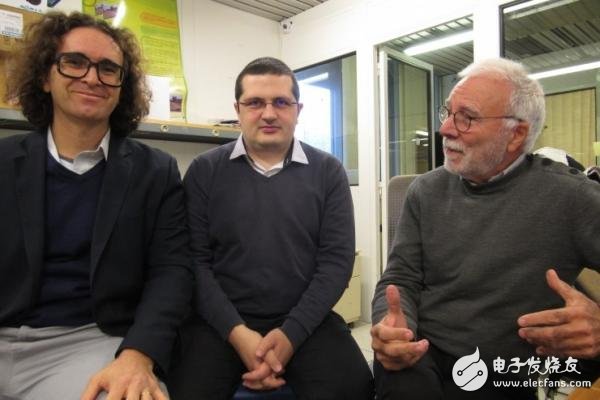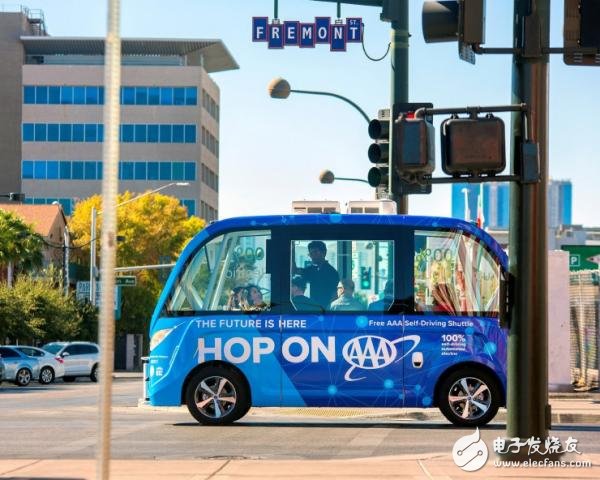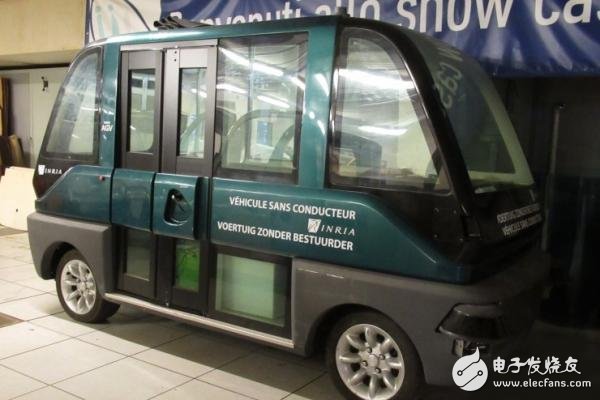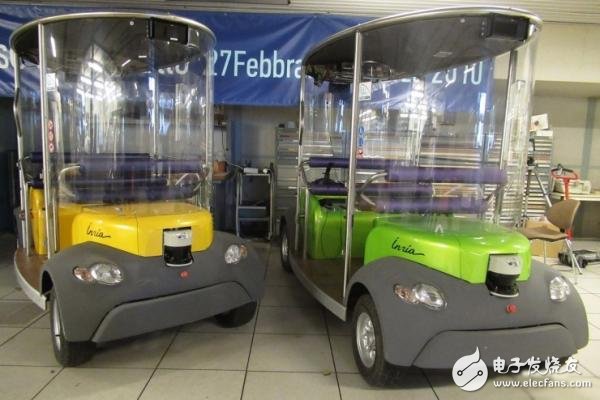For the autopilot market, almost all of the arguments have been templated. They are nothing more than saying that autonomous vehicles will make roads safer and greatly improve passengers' living efficiency. At the same time, traffic sharing solutions from self-driving cars will also reduce car ownership, and urban congestion and pollution problems will be solved. In fact, such a conclusion is somewhat utopia. The technology industry has spared no effort in selling bigger, faster, smarter technologies, and the media are cheering cheerleaders.

AutoKab three King Kong: Carlos Holguin, CrisTIan Sandu and Michel Parent
However, the reality is not as exciting as the release, and Navya's self-driving shuttle bus has a small car accident on the first day in Las Vegas.
The media and the public, and even the community of engineers, are clamoring for the concept of self-driving cars to grab drivers' jobs. Many engineers are awe-inspiring to the super-computing power of AI, and they are beginning to think about how wonderful the connected world of cloud computing will be.
For the autopilot market, almost all of the arguments have been templated. They are nothing more than saying that autonomous vehicles will make roads safer and greatly improve passengers' living efficiency. At the same time, traffic sharing solutions from self-driving cars will also reduce car ownership, and urban congestion and pollution problems will be solved.
In fact, such a conclusion is somewhat utopia. The technology industry has spared no effort in selling bigger, faster, smarter technologies, and the media are cheering cheerleaders.
Indeed, to demonstrate whether a technology is crushing another technology, you can find many reasons. However, when making these judgments, few people will think about a basic premise, or a question that is full of initial thoughts: Why do you want to build a self-driving car? What is it used for?
Automated R&D has been in development for 20 years. Carlos Holguin and Michel Parent are the CEO and Chairman of AutoKab, respectively. The startup is committed to “developing safety-assured automation technology for commercial fleetsâ€. The company’s office is located in the French Institute of Computer Science and Automation (INRIA), which was originally the central command of the NATO army. unit.
Although only two years after its founding, AutoKab's founders are experts in the transportation industry with more than 20 years of experience in public transportation planning, road vehicle automation and operations.
AutoKab's R&D center looks like a garage, with a variety of old-fashioned autopilot shuttles, golf carts and passenger cars, all of which have been the test of the past 20 years, and it has become the Automated Car History Museum.
It is understood that Michel Parent's career is closely linked to the car, half of which is contributed to Stanford, MIT and INRIA related research institutes, and the other half is spent in the robot industry. He contributed a lot of ideas to the "automation" of transportation. .
Parent said: "20 years ago, I always wanted to design a robot that can drive like a human. Later I asked myself a question, what is the fun of developing such a robot?" However, he thinks that the most self-examination is "we are What problem are you trying to solve?"
For the city, what is to be solved is “urban diseaseâ€, that is, traffic congestion, space shortage, inconvenience in travel and energy waste. “We need public transport vehicles that can be connected and shared and faster,†says Parent. Holguin concluded: "The last mile is the most urgent problem we have to solve."
“If autopilots don’t use sharing modes like buses and taxis, they can’t solve traffic congestion. In some cases, they can even increase congestion.†In his opinion, AutoKab’s goal is to solve “one car.†One person's waste of transportation resources.
AutoKab's key employees come from two different worlds: “technology†and “trafficâ€. Holguin said: "We are using technology to fill the lost links in the commercial operation of autonomous vehicles." To be precise, they are developing an "automation service" product for public transport operators.
Automation kit for cars and buses
AutoKab specializes in the development of both security and data analytics technologies, and the company is working with cities to achieve more efficient public transportation.
In fact, the name of AutoKab comes from the acronym "AutomaTIon Kits for Autos and Buses" (the automation kit for cars and buses). Of course, it also has the ability to develop hardware. CrisTIan Sandu, the company's CTO, said that AutoKab's automation kit can be installed on any vehicle, including a large number of sensors such as radar, laser radar, vision systems and processors (suppliers including Intel and NVIDIA).
However, Sandu pointed out that it would take a lot of effort to install this kit perfectly on a car (depending on the vehicle, via CAN bus or FlexRay), including software calibration. Of course, it doesn't take a lifetime to install, and users can choose to uninstall the automation kit. AutoKab bets the kit not because it is interested in selling hardware, but because it is critical to reducing the cost of autonomous vehicles.
Holguin also stressed that AutoKab is not interested in selling hardware. Instead, it is more focused on working with major cities to develop plans to more efficiently address the last mile of service. As for the profit model, it is divided into the profit per mile of the self-driving car.
"The cost is too high"AutoKab is involved in several European projects, including CityMobil2. Holguin pointed out that in the 7-month autopilot test from October 2014 to April 2015, it achieved good results with zero accidents and carried more than 60,000 passengers.
In addition, local residents’ evaluation of self-driving cars is also quite high. However, they did not know that this was just a test. More importantly, the media and the public are not concerned about the data collection problem in the test.
AutoKab has accumulated a lot of experience when participating in EU projects. “We understand what is hidden behind the data,†says Sandu. First of all, even a low-speed, self-driving car is very expensive to operate. In addition, these vehicles for sharing are often left unattended. If the self-driving car and the public transportation can't coordinate with each other, it is a fantasy to upgrade the service.
Sandu also pointed out that the number of passengers in autonomous vehicles needs to be determined according to the actual situation of different cities.
During the demonstration phase of the CityMobil2 project, two test teams from partners Robosoft and Easy Mile were staged in seven cities, but these vehicles were not necessarily suitable for testing the city.
“We used these cars to test because we only have them at hand,†says ChrisTIan. If you really want to deploy autonomous vehicles, you need to do further analysis.
Second, the city must also have an adaptation period. Holguin said: “They need to invest in infrastructure like V2X traffic lights.†Autonomous vehicles are not a panacea for all cities, and urban traffic issues require more comprehensive considerations, including the area where passengers are driving.
Two different waysFor the layman, Waymo's self-driving car is quite cool. As for Navya's self-driving shuttle bus, the coolness is much less.

Las Vegas Navya Shuttle
In the United States, people are dismissive of the commitment of the transportation sector or politicians to improve urban infrastructure, because these commitments are difficult to deliver.
Since Americans have a serious sense of distrust of the city government, new facilities such as V2X traffic lights and self-driving cars are built by Google, NVIDIA and Intel/Mobileye. However, these tech giants do not seem to be willing to take the lead. Their goal is to automate their vehicles without changing the existing infrastructure.
In Europe, on the contrary, projects such as CityMobil2 that require EU investment require autonomous vehicles to be part of the Automatic Road Traffic System (ARTS).
The European Union has defined ARTS as “ARTS is a road-based system based on fully-automated vehicles (without steering wheel), with a priori knowledge of the infrastructure they are using. Even ARTS vehicles without fully automatic driving functions will Real-time remote monitoring and management by human operators in the control center."
As a result, Europe and the United States have adopted completely different attitudes in autonomous driving. In Europe, “a priori knowledge of infrastructure†and “certification requirements†are key words for autonomous vehicles.
Established routeRegarding the issue of AI on self-driving cars, AutoKab's Sandu said straightforwardly: "We are not interested in deep learning. We have our own established method, and the traffic control department can more easily certify self-driving cars."
Previously, Philip Koopman, a professor at Carnegie Mellon University, said that the biggest challenge facing autonomous vehicles is actually the most basic problem hidden in machine learning tests, which has been plaguing the science and engineering community for a long time. “It is not easy to get a machine learning-based system to meet traditional security standards,†Koopman said. “Because the training data set does not meet the design requirements of traditional software.â€
AutoKab believes that in order to be certified by commercial autonomous vehicles, automakers must create products that provide safety assurance to regulators.
Parent stressed, “A self-driving car needs to be certified like the current train, bus and plane.â€
Picking up problems in the car
As a robotic expert in the “sand-court†field, Parent said that the current self-driving car reminds him of the classic “catch problemâ€.
Last year, the Robotics Industry Association described in a story the dilemma of facing this problem. “Although the technology is constantly improving, the ability to pick up objects in the robotic cabin is still limited. We still haven't been able to find a real breakthrough. However, we still have some gains, with the help of advanced visual technology, software and capture solutions. The robot is moving forward step by step in the field that has never been involved."
"So, why is it so difficult for robots to learn to crawl randomly? The crux of the answer lies in the accuracy. Although the robot has super-repetitive ability, in the chaos, random crawling still requires high accuracy. The robot needs to be in the available space. Positioning a component, this space is not only free and open, the parts are always changing position and orientation. This means that the robot needs to balance sensitivity, machine vision, software and computing power, so that all data can be processed in real time. A fetching plan. Although such a requirement is very high, it is by no means impossible."
At the moment, the robot and autopilot industry are mainly relying on the improvement of computing power to solve this problem. However, in the Parent view, “we can also solve the same problem by arranging components on neat and flat pallets, so that the robot's gripping speed can be improved.†In other words, before releasing the robot We have to solve the chaos.
Parent believes that this kind of thinking can be used in self-driving taxis and shuttles, which can reduce the confusion on the infrastructure and solve urban traffic problems more quickly.
Here are a few self-driving cars in the AutoKab Museum, the epitome of the autonomous driving industry for the past 20 years.

This golf cart-shaped car was born in 1995. It was developed by the INRIA-IMARA/RITS team. It was officially put into mass production in 1996 and has undertaken the development and testing of autonomous driving services in several cities. It also serves in Italy.
Yamaha self-driving guided vehicle

The Yamaha self-driving guided vehicle was jointly developed by INRIA and Yamaha. It was officially launched in 2000 and subsequently retrieved at the headquarters of AutoCab and in Norway, Italy and other countries.
La Rochelle's self-driving car

These vehicles were also used in technology development and transportation service demonstrations, first on the road in La Rochelle, France, and then in Antibes, France and Calabria, Italy.
ZGAR Aurora 2500 Puffs
ZGAR electronic cigarette uses high-tech R&D, food grade disposable pod device and high-quality raw material. All package designs are Original IP. Our designer team is from Hong Kong. We have very high requirements for product quality, flavors taste and packaging design. The E-liquid is imported, materials are food grade, and assembly plant is medical-grade dust-free workshops.
Our products include disposable e-cigarettes, rechargeable e-cigarettes, rechargreable disposable vape pen, and various of flavors of cigarette cartridges. From 600puffs to 5000puffs, ZGAR bar Disposable offer high-tech R&D, E-cigarette improves battery capacity, We offer various of flavors and support customization. And printing designs can be customized. We have our own professional team and competitive quotations for any OEM or ODM works.
We supply OEM rechargeable disposable vape pen,OEM disposable electronic cigarette,ODM disposable vape pen,ODM disposable electronic cigarette,OEM/ODM vape pen e-cigarette,OEM/ODM atomizer device.

Aurora 2500 Puffs,Pod System Vape,Pos Systems Touch Screen,Empty Disposable Vape Pod System,2500Puffs Pod Vape System
ZGAR INTERNATIONAL(HK)CO., LIMITED , https://www.zgarvapepen.com